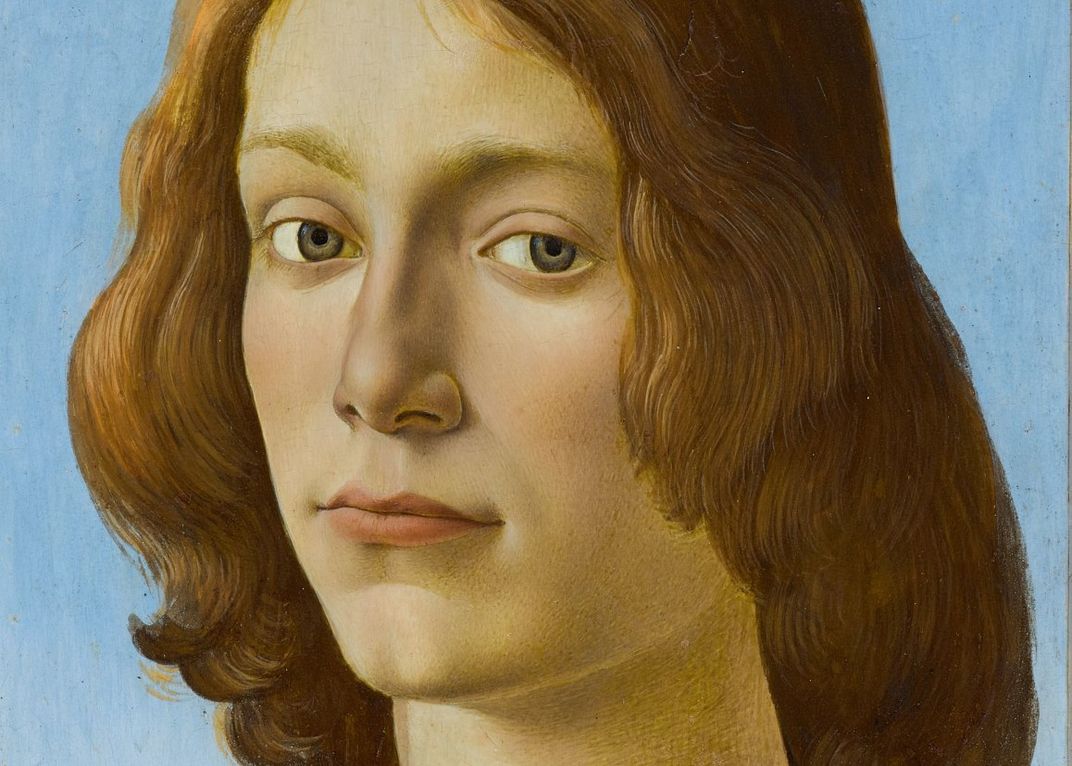One of the Last Privately Owned Botticelli Portraits Just Sold for $92 Million
The 15th-century painting, which went up for auction at Sotheby’s Thursday, depicts a young Florentine man
:focal(396x152:397x153)/https://tf-cmsv2-smithsonianmag-media.s3.amazonaws.com/filer/d8/1b/d81bd6b8-7ad8-4e4d-bbb7-e0fd9ad4dee2/botticelli_man.jpg)
Editor's Note, January 28, 2021: Sandro Botticelli's Portrait of a Young Man Holding a Roundel sold at Sotheby's today for $92.2 million—the highest price paid for an Old Master painting since Leonardo da Vinci's record-breaking Salvator Mundi fetched $450 million in 2017, reports Katya Kazakina for the New York Times. Read more about the 15th-century work's history below.
A pared-down Sandro Botticelli portrait of a young Florentine man is poised to sell for an astronomical amount when it goes up for auction in January 2021.
Initial estimates for Young Man Holding a Roundel hover around $80 million—the highest estimate for an Old Master painting that Sotheby’s has ever set, the auction house tells the Guardian’s Mark Brown.
Botticelli painted Young Man between the late 1470s and early 1480s, according to a Sotheby’s statement. The first recorded mention of the work dates to the 1930s, when it was housed at a British nobleman’s Welsh estate. The painting changed hands several times before being sold to a private collector for £810,000, or roughly £2.5 million today ($3.2 million USD), in 1982.
Over the past half century, the portrait has been exhibited at a number of major cultural institutions, including the Metropolitan Museum of Art in New York City; the National Gallery in London; and the National Gallery of Art (NGA) in Washington, D.C. But doubts surrounding its authorship persisted until 1987, when art historian Richard Stapleford established Young Man’s status as a genuine Botticelli beyond a reasonable doubt.
As NGA curators observed in a 2001 exhibition catalog, “Given the superb quality and inventiveness of the portrait, it is surprising how often scholars have questioned its attribution to the [Renaissance] master.”
Only a dozen or so Botticelli portraits survive today. This work is one of three housed in a private collection rather than a museum, reports Margaret Carrigan for the Art Newspaper.
“This painting is not just the greatest Botticelli in private hands but is to be considered amongst the finest Renaissance paintings in private ownership,” Christopher Apostle, head of Sotheby’s Old Master painting department, tells Lily Smith and Oscar Holland of CNN.
Today, many of Botticelli’s most famous works—including Primavera and the enormous, elaborate Birth of Venus—are synonymous with the Italian Renaissance. Compared with these compositions, Young Man stands out for its relative simplicity. The sitter, framed by a stark background of bright blue sky and a rectangular window, faces the viewer with a serene gaze. In his hands, he holds a roundel, or small circular frame, featuring a small piece of an entirely different painting.
This unusual addition has puzzled scholars for generations. Carefully affixed to the canvas, the roundel work depicts an elderly saint with a long beard, framed against a golden background.
Most researchers attribute the portrait of the saint to Sienese painter Bartolomeo Bulgarini, who was active about a century before Botticelli created Young Man, per Sotheby’s. But when and why the roundel was added remain points of contention.
Stapleford argued in his 1987 study that the medallion is “original to the painting.” Art historian Keith Christiansen, meanwhile, suggested the roundel was a “modern addition” that replaced a damaged stucco relief.
As Brown notes for the Guardian, some scholars have argued that the inclusion of the elderly saint is meant to highlight the relative youth and beauty of the sitter, as well as perhaps offer a clue to the sitter’s identity.
Scholars are unsure who the portrait depicts, though some have speculated—albeit with little evidence—that the man is Giovanni di Pierfrancesco de’ Medici, whose second cousin Lorenzo the Magnificent was one of Botticelli’s most important patrons, according to the statement.
Botticelli took pains to depict the young man as the pinnacle of Renaissance beauty ideals. X-ray imagery of the painting shows that the artist carefully plotted out the man’s features in underdrawings, in addition to revising various aspects of the painting.
“Though modest and restrained, the young gentleman’s clothing is clearly of the finest quality, and his elegant and contemplative demeanor embody the neo-Platonist and humanist philosophies that defined the culture of the Florentine elite,” says Sotheby’s in the statement.
“Our Young Man is 550 years old, yet he looks like he could have strolled into our galleries this morning,” George Wachter, Sotheby’s co-chairman of Old Master paintings, tells the Guardian. “He is a true beauty for the ages.”
/https://tf-cmsv2-smithsonianmag-media.s3.amazonaws.com/accounts/headshot/nora.png)
/https://tf-cmsv2-smithsonianmag-media.s3.amazonaws.com/filer/b1/66/b166277a-c9e2-4385-bbf4-f2f9e771820e/detail.jpeg)




/https://tf-cmsv2-smithsonianmag-media.s3.amazonaws.com/filer/ea/bc/eabc3829-ca8b-4653-bfd4-e131ed731a7d/botticelli.jpg)
/https://tf-cmsv2-smithsonianmag-media.s3.amazonaws.com/filer/b4/09/b4099c81-66a4-439a-b45d-61749bb3dff6/1280px-giuliano_de_medici_by_sandro_botticelli.jpeg)
/https://tf-cmsv2-smithsonianmag-media.s3.amazonaws.com/accounts/headshot/nora.png)